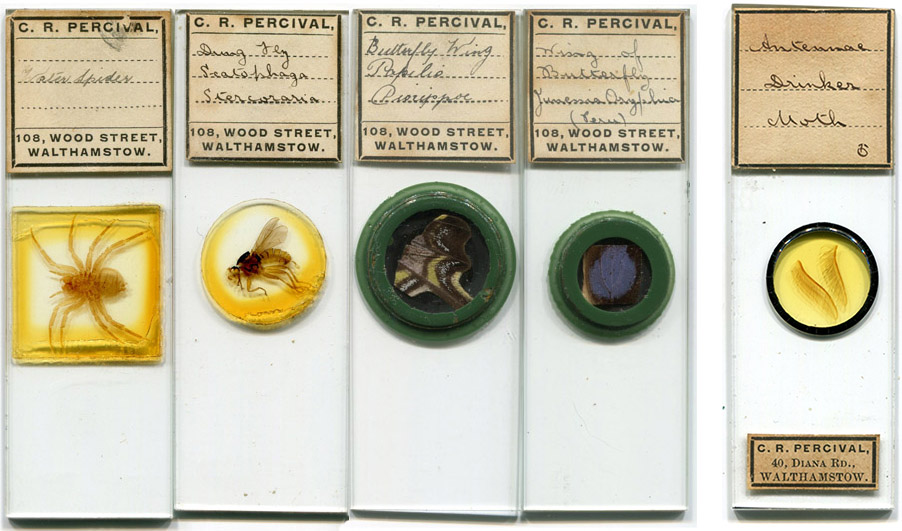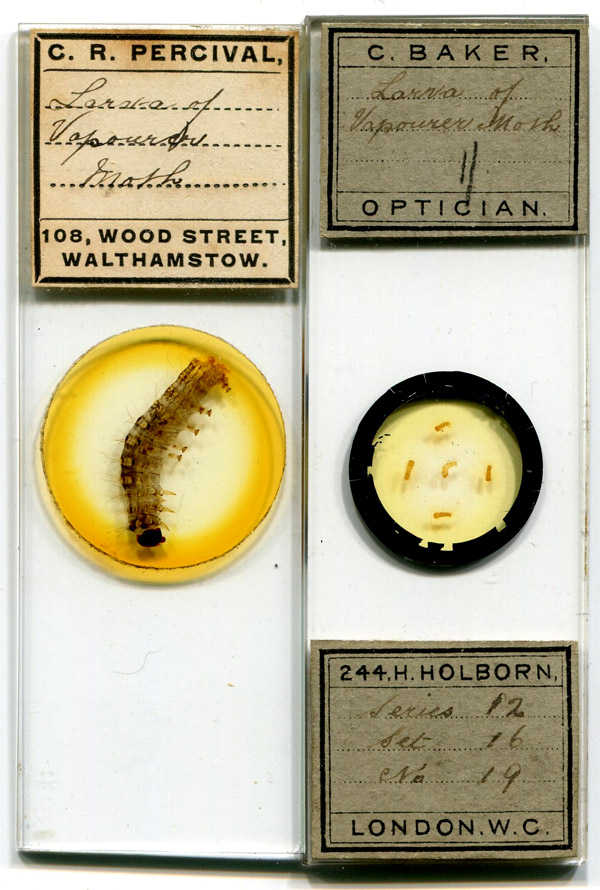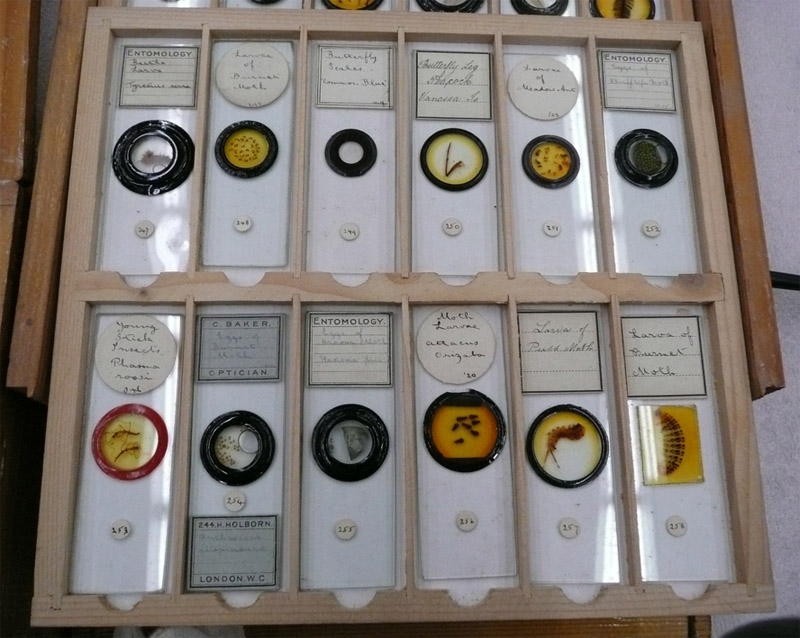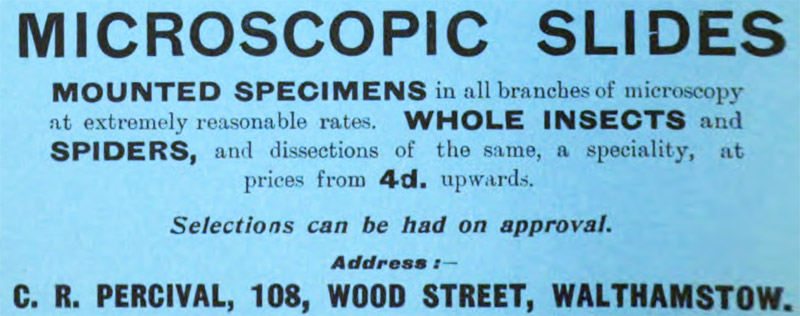Charles Robert Percival, 1879 – 1960
by Brian Stevenson
last updated September, 2014
C.R. Percival
was a professional slide maker, operating in Walthamstow, London, England from
ca. 1900 to 1914, then in Toronto, Canada until near the time of his death.
Percival’s English slides can be dated by the address on his labels: he lived
at 108 Wood Street until at least November of 1906, and at 40 Diana Road from
1907 until 1914 (Figure 1). In addition to selling slides under his own label,
handwriting similarities suggest that Percival also produced slides for the
major London microscope business of Charles Baker (Figures 2 and 3).
Photographs of slides in Percival’s personal collection include many unsigned
mounts bearing handwriting similar to his (Figure 3), suggesting that unattributed microscope slides in some collections may have been produced by Percival.

Figure 1.
Microscope slides produced by Charles Percival during his time in England. He mounted a wide variety of specimen types, from insects to plants to chemicals for polariscopy. The slides with his address of 108 Wood Street date from ca. 1900 until ca. 1906, while those from 40 Diana Road date from ca. 1907 until 1914.

Figure 2.
C.R. Percival may have produced microscope slides
for the large London microscope firm of Charles Baker. A microscope slide
bearing Baker labels, and handwriting that is very similar to that of
Charles Percival, alongside a similar Percival-labeled slide. Baker is well
known to have sold, under their own label, microscope slides prepared by
professionals such as Eduard Thum, Amos Topping and Ernest Hinton.

Figure 3.
A selection of microscope slides that were in C.R.
Percival’s personal collection at the time of his death. Many of the
illustrated slides carry handwriting similar to that of Percival, suggesting
that he may have manufactured some or all of these slides. This includes the
Baker-labeled slide in the lower row. Adapted from an image of the C.R.
Percival Collection of Canada Science and Technology Museum, and used here for
nonprofit, educational use as per Creative Commons understandings. See the
Resources section for complete citation.
Charles
Robert Percival was born in the spring of 1879 in the Haggerston area of
Shoreditch, London. He was the second son, and third child, of Elizabeth and
Robert Percival, a printer.
C.R.
Percival attended Dame Alice Owens’ School in Islington, London during the
early 1890s. At school, he was close friends with Frank P. Smith, who later
became a noted microscope slide-maker, magazine editor, film-maker and expert
on spiders. According to family oral history, Percival and Smith remained
microscopy associates until Percival left England. The earliest known slide by
Percival dates from his school years. A mount dated May 4, 1896 was included in
his personal collection at the time of Percival’s death.
The 1901
census shows 21 year-old Charles living with his parents and four siblings. He was employed as a clerk for a “fancy
goods dealer”. At around this time, Charles began to professionally produce slides. His 1904 marriage license to Florence Elizabeth Bilby stated that his occupation was microscope slide-maker.
Percival
advertised his slides in popular and specialist magazines such as The Journal of the Quekett Microscopical
Club and The English Mechanic (Figure 4). As noted above, handwriting comparisons suggest that Percival also prepared slides for Baker. That observation raises the possibility that he may also have supplied other retailers.

Figure 4.
A 1906 advertisement from the inside cover of ‘The Journal of the Quekett Microscopical Club’. Percival’s friend and colleague, Frank P. Smith, was then editor of the journal.
Percival’s
microscopy collection included several letters from customers, providing interesting insights on person-to-person postal sales. Three letters survive from Joseph P. Wright of 37 Ravenswood Road, Redland, Bristol, dated June 6, 1906 and January 27 and February 9, 1907. In each letter, Wright acknowledges that he received a shipment of approximately 50 slides, has kept most but is returning a few, and enclosing a check to pay for those he retained. Stated prices paid were 15 Shillings for 45 slides and 11 Shillings 4 Pence for 34 slides. The customer made his needs known to Percival, “I am not in want of Lepidoptera, Spiders or Coleoptera unless they are of special interest. Collembolla (sic), Hemiptera, Geological, or any on the list I sent you will be welcome”.
The 1911
census recorded that Charles Percival described himself as being a “ledger clerk” in a “fancy warehouse” (Figure 5). The 1911 census differed from all the previous English censuses in that each householder filled out the information him/herself. Thus we are provided with further samples of Percival’s handwriting, which can be of benefit to collectors attempting to identify the maker of unsigned or Baker slides.

Figure 5.
Excerpts of the Percival family’s entry in the 1911 census of England. The handwriting is Charles’, which can be helpful to collectors in identifying Percival’s unsigned microscope slides.
On March
11, 1914, the Percival family emigrated to Toronto, Canada. The son, Walter,
suffered from chronic bilateral mastoiditis, which is a persistent infection of the
mastoid parts of the skull. Associated with untreated otitis media (middle ear
infections), mastoiditis was a leading cause of death in children in the
pre-antibiotic era. Toronto’s Hospital for Sick Children was then renowned for
treatment of mastoiditis, which was the reason for the Percival’s relocation.
Charles acquired a clerk job at Toronto’s Ontario Club, and remained there
until he retired.
Percival
continued to produce microscope slides in Canada, although the market was
probably smaller there. While there is no direct evidence, he may have
continued to supply the English market, possibly through retailers such as
Baker. His personal collection includes slides dated as late as 1954. C.R.
Percival died in Toronto in August, 1960.
Resources
Bracegirdle, Brian (1998) Microscopical Mounts and Mounters, Quekett Microscopical Club,
London, pages 74 and 162, and plate 29-F (note: page 74 misprinted Percival’s
initials as “C.E.”)
Canada Science and Technology Museum, C.R. Percival
Collection (accessed September, 2013) Images of Percival’s slides, microscope
and mounting materials,
http://www.flickr.com/photos/scitechcurator/sets/72157629702379385/
England census, birth and marriage records, accessed through
ancestry.co.uk
Journal of the Quekett
Microscopical Club (1906) advertisement from C.R. Percival, Series 2,
Vol. 9, November issue, page ii
Journal of the Royal
Microscopical Society (1910) “Frank P. Smith says he has had several complaints as to the difficulty of obtaining
Miller’s cement, and that ‘C.R. Percival, the well-known mounter, to whom I
communicated this method some years ago, tells me he has used as a substitute
an India-rubber cement supplied by Grübler, with complete success”, page
385
Passenger list of the “Royal Edward” (1914) accessed through
ancestry.co.uk
Suttie, Boyd (2000) C.R. Percival: the work and equipment of
a professional slide preparer, Rittenhouse,
Vol. 14, pages 77-94




